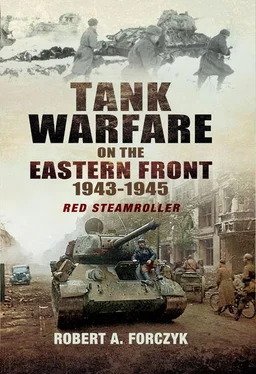On 5 January, both Kampfgruppe Bachmann (Pz. Regt. 201) and Kampfgruppe Post (17 Tigers and 20 Pz III from s. Pz.-Abt. 503) conducted probing attacks eastward and encountered strong resistance from the vanguard of Sharagin’s corps near the village of Stavropol. {17} The next day, von Vormann mounted a deliberate assault upon the Soviet mechanized brigade in Stavropol, with the Tigers mounting a frontal assault while Kampfgruppe Bachmann enveloped the town. The Luftwaffe managed to provide a few Stukas to support the attack, but the Tigers received only limited infantry and artillery support. The attack on Stavropol was noteworthy as the first major combat experience of the Tiger tank on the Eastern Front and the first time that the Germans encountered the new-style Soviet mechanized corps on the defence. In between snow squalls, the Tigers moved across the flat terrain toward the town in several wedge formations, with a thin screen of dismounted infantrymen following. The Soviet mechanized brigade in Stavropol had about 20–25 tanks in support, as well as a battalion of 76.2mm cannons and 12 45mm anti-tank guns. The Soviet 76.2mm guns succeeded in destroying one of the Pz IIIs and inflicted heavy losses on the German infantry, but could not stop the Tigers. Instead, the Tigers knocked out 13 Soviet tanks and several artillery pieces. However, it was the outflanking manoeuvre by the Pz IIIs and Pz IVs of Kampfgruppe Bachmann that forced the Soviet mechanized brigade to retreat. The next day, Kampfgruppe Bachmann continued to pursue the defeated Soviet brigade eastward but by 8 January it had nearly exhausted its supplies; Panzer-Regiment 201 was reduced to just 3–4 Panzergranate rounds and 300 machinegun rounds per tank and about 140 litres of fuel – just enough to make it back to Proletarskaya. {18}
While von Vormann was pushing one of Sharagin’s brigades back, the others were pushing into the centre of 23. Panzer-Division’s sector near the village of Vessely. Without Bachmann’s panzers, von Vormann’s command post was nearly overrun and Sharagin’s infantry and tanks threatened to split the LVII Panzerkorps’ defence. Von Vormann ordered an immediate attack against the Soviet force in Vessely, including the Tigers from Kampfgruppe Post and the exhausted Kampfgruppe Bachmann. At 0930 hours on 9 January, the German counter-attack began with 11 Tigers and 12 Pz III Ausf N lumbering across the open steppe toward Vessely. Indeed, the Tigers were moving across the snowy terrain at just 10km per hour – little more than the British Mark V tank in the First World War. However, in the 24 hours since taking the village, Sharagin had reinforced the mechanized brigade here with additional tanks, artillery and anti-tank guns, which gave the Germans a warm welcome. Amazingly, the first German assault was repulsed and the accompanying German infantry suffered crippling losses. Undeterred, von von Vormann personally ordered a second assault and a third – both of which were repulsed. While the Tigers managed to destroy eight T-34s over the course of the 6-hour battle, two Tigers were knocked out by 76.2mm fire and all the rest suffered considerable damage. In addition, 2 Pz III Ausf N were destroyed and seven more damaged. {19} One Tiger was hit 11 times by 76.2mm fire and 14 times by 57mm; although the fighting compartment was not penetrated, the tank was reduced to a wreck. Bachmann’s panzers also suffered heavy losses and were reduced to just seven operational tanks. {20} The German panzer counter-attack at Vessely was a costly fiasco that reduced both the 23. Panzer-Division and s. Pz.-Abt. 503 to combat ineffectiveness. Sharagin’s mechanized troops had won an impressive defensive victory which did not go unnoticed by the Stavka.
Von Vormann wasn’t willing to accept defeat and when a trainload of replacement tanks arrived in Salsk, he used them and the last two Tigers to form a new armoured spearhead, Kampfgruppe von Winning. On 11 January, Kampfgruppe von Winning succeeded in eliminating most of a Soviet artillery battalion west of Vessely, but at the same time Sharagin’s corps was overrunning the 23. Panzer-Division’s SPW battalion to the south, at Krasny Skotovod. Kampfgruppe von Winning re-oriented southward and the next day launched a major counter-attack against the Soviet mechanized brigade at Krasny Skotovod. Despite receiving fire support from 23. Panzer-Division’s entire artillery regiment and two Stukas, the attack was a failure. Not only did the Soviet mechanized brigade retain the town, but it was now apparent that Kirchner’s LVII Panzerkorps could no longer remain north of the Manych River much longer. Over the next few days, the panzers, assault guns and remaining infantry conducted a delaying action back to Proletarskaya. The 2./s. Panzer-Abteilung 502, supporting the 17. Panzer-Division, knocked out 11 Soviet tanks but was reduced to just 3 operational Tigers. On 14 January the 17. Panzer-Division pulled south of the Manych, followed by the 23. Panzer-Division on 16 January. During the retreat, Kirchner’s LVII Panzerkorps destroyed hundreds of vehicles that could not be repaired or were immobilized by lack of fuel. In the harsh winter weather, the retreat was hazardous and Mühlenkamp’s SS-Panzer-Abteilung 5 lost three Pz IIIs that slid off the road into ditches and had to be abandoned. {21} Once the rest of Kirchner’s corps had crossed the 1,000-meter wide Manych, the SS- Wiking Division, reinforced with the last 2 operational Tigers, deployed into a hedgehog to defend the bridgehead at Proletarskaya as long as possible.
In no time, Sharagin’s 3GMC, reinforced with additional infantry and artillery from the 28th Army, was pressing against SS- Wiking ’s perimeter. Furthermore, Malinovsky’s 2nd Guards Army had shifted its line of march westward and was threatening to cross the Manych in a sector that was screened by the 16. Infanterie-Division (mot.), which only had a few Pz IIIs left. Mühlenkamp’s battalion succeeded in repulsing several Soviet infantry probes into Proletarskaya but he had just 10 tanks still operational and Soviet artillery fire was gradually pulverizing the town. {22} The SS- Wiking managed to hold Proletarskaya until dusk on 19 January, giving additional time for Kirchner’s LVII Panzerkorps and Panzerarmee 1 to retreat toward Rostov. Then the SS troops broke contact, blew up the bridge over the Manych and joined the retreat to Rostov. Although Sharagin’s 3 GMC, joined by the 4th Guards Mechanized Corps. did an excellent job hounding Hoth’s retreat, Malinovsky was shifting his armour westward along the northern side of the Manych, looking for a crossing site to cut off their escape route to Rostov. Malinovsky formed an armoured group consisting of General-mayor Karp V. Svirodov’s 2nd Guards Mechanized Corps (2GMC), General-leytenant Pavel A. Rotmistrov’s 3rd Guards Tank Corps (3 GTC) and General-major Semen I. Bogdanov’s 5th Guards Mechanized Corps (5 GMC) and tasked them to cross over the Manych near its confluence with the Don at Manychskaya and head toward Bataisk, only 40km away. If Rotmistrov’s armour reached the bridge over the Don at Bataisk, Heeresgruppe A’s primary escape route from the Caucasus would be severed. Although running short on fuel and ammunition after their long advance across the steppe, Rotmistrov put one of his ablest subordinates, Polkovnik Ivan A. Vovchenko in the lead with the 3rd Guards Tank Brigade (3 GTB) and they succeeded in crossing at Manychskaya on 22–23 January. Since Rotmistrov’s advance threatened to get behind PzAOK 4, Hoth shifted the 17.Panzer-Division to guard his escape route and asked von Manstein to temporarily transfer part of Generalleutnant Herman Balck’s 11. Panzer-Division south of the Don to meet this threat.
After some preliminary skirmishes with Vovchenko’s brigade on 24 January, Balck’s 11.Panzer-Division spearheaded a counter-attack on 25 January against the Manychskaya bridgehead. By means of a clever feint attack, Balck was able to defeat Vovchenko’s 3 GTB and knocked out 20 Soviet tanks. {23} In his memoirs, Rotmistrov claimed that Vovchenko’s brigade was attacked by 120–150 enemy tanks and three to four regiments of infantry, but Balck’s force was about 30–40 tanks and two motorized infantry battalions. Rotmistrov also claimed that Vovchenko’s brigade knocked out 20 German tanks, but admitted in his memoirs that, ‘we suffered great losses in manpower and material’ and asked Malinovsky permission to shift to the defence in this sector. {24} Malinovsky agreed, not realizing how small the German blocking force was in this sector. Thus Balck’s armoured Kampfgruppe stalled the advance of the Soviet 2nd Guards Army for the better part of a week and held the corridor open long enough for Hoth’s battered panzer units to conduct a fighting retreat to Rostov. Here and there, the remaining German panzers turned and inflicted some losses on their pursuers, but by the time that Hoth reached Rostov’s outskirts on 31 January, his ‘panzer army’ was reduced to fewer than 50 operational tanks and assault guns.
Читать дальше








![John Stieber - Against the Odds - Survival on the Russian Front 1944-1945 [2nd Edition]](/books/405234/john-stieber-against-the-odds-survival-on-the-russian-front-1944-1945-2nd-edition-thumb.webp)



